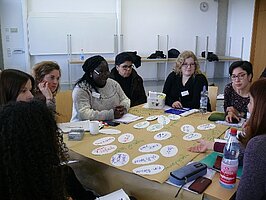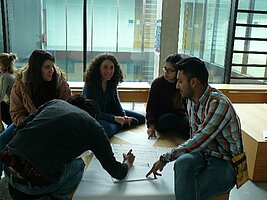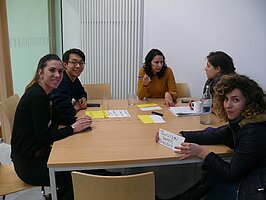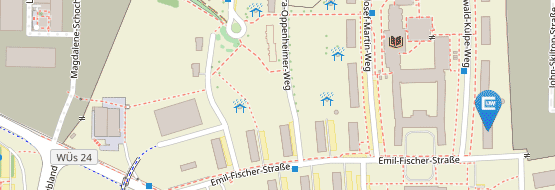International Variation of the Group Puzzle



Aim of the method/strategy
- to make the diverse perspectives of international students visible
- to get insights into diverse international contexts in adult education
- to strengthen students’ responsibility for their learning processes and their contribution to the shared learning setting
- to make preparatory reading necessary for successful participation in on-campus classes
Setting
- Classroom, moveable tables and chairs
Type and name of the course, curriculum, number of students
- Preparatory class for the Adult Education Academy (master’s and doctoral students in education), master’s students in education
Description of the method/ strategy
Participants are given a reading assignment prior to the on-campus class (e.g. ‘please prepare a country report on adult education in your home country; please find information about its history, participation, offerings, financing, legislation, and professionalisation’). Each student completes the reading at home at his/her own responsibility. Students are asked to use the INTALL information tool (https://www.hw.uni-wuerzburg.de/intall/adult-education-academies/information-tool/).
During the on-campus session, the groups are divided into international groups, each featuring students from to two or three different countries. Each student group is asked to develop a poster on one or two of the categories (e.g. history, participation, offerings, financing, legislation, and professionalisation). The posters are presented to the plenary group at the end of the on-campus session.
I use this strategy as a first exercise for the preparation course of the Adult Education Academy. It helps very much making students aware of their role in the learning process: They are the experts on their home countries and not the moderators of the group. Normally, this exercise helps very much making the group curious about adult education in different countries. Participants raise questions that others try to answer. So both group work and plenary presentations are strongly marked by questions, reflections, and a ‘joint search for understanding’.
Materials required
- posters, coloured pens, and moderation cards, if available
Origin and theoretical framework
The method is also called Jigsaw Classroom (https://www.jigsaw.org/) or Group Expert Rallye (see http://methodenpool.uni-koeln.de/rallye/rallye_kurzbeschreibung.html). In its classic format, the method is used to group participants in different phases in different groups, starting with a main group (e.g. group 1: A1, A2, A3, A4, group 2: B1, B2, B3, B4, group 3: C1, C2, C3, C4, group 4: D1, D2, D3, D4). Afterwards, the main groups are regrouped into mixed groups (e.g. group 1: A1, B1, C1, D1, group 2: A2, B2, C2, D2; group 3: A3, B3, C3, D3, group 3: A4, B4, C4, D4). While the main groups work on their topic, the mixed groups disseminate the topic to the other groups. In a third round, the main group meets again and shares their learning within the mixed groups.
The method was developed in the 1970s by E. Aronson (e.g. Aronson & Bridgeman, 1979) to support collaborative learning and to strengthen learner responsibility. K. Reich (2008) adapted the method against the background of constructivist learning theory. The method very much supports constructivist learning theory by putting learners’ different perspectives at the centre and using them as learning resources for group learning processes.
Risks and advantages
Advantages:
- The method supports the responsibility of single participants during the whole learning process.
- International group work helps learners practice their English in small student groups.
- The methods support active and deeper learning processes, as participants turn into teachers when presenting their results.
- The on-campus group work session supports quiet learners to become active in a small group. The development of a poster with results gives them a concrete ‘agenda’ for their presentation.
Risks:
- The method is only suitable for groups of up to 20 to 30 persons. Otherwise, the grouping will become to complicated, and exchanges between the groups become ineffective.
- The method requires proper time management. This refers to the quality of participants’ preparation and to the concrete task given to participants.
- It is important to give participants a concrete task so they know what they should work on. Otherwise, group work may be ineffective.
- The method only works if participants are properly prepared for the task.
Possible variations
- I also use group puzzles to divide long reading assignments. I break down a long text (e.g. 80 pages) into smaller parts (e.g. 4 sections at 20 pages). Then I divide the group into four subgroups. Each subgroup reads one of the four parts. The classroom activity then focuses on exchanges about the four parts and on learning from each other.
Other examples where you think it could be used
- Group puzzles may also be used without a preparation if it refers to participants’ experiences. Then a first round may be used for collecting shared experiences, which may then be shared with the other groups in the second round.
Recommendation
- The task should be planned in detail in advance, and students should be given detailed information on how to prepare.
- The time planning during the classroom session should be planned in detail.
- It is important to value the contributions of students and to support them in their group work.
Annexes
In English:
- The Jigsaw classroom: https://www.jigsaw.org/
In German:
- ZUM-Plattform: https://unterrichten.zum.de/wiki/Gruppenpuzzle
- Methodenpool: http://methodenpool.uni-koeln.de/rallye/rallye_kurzbeschreibung.html
- Results of the Methods in Preparatory Class (November 2018)
References
Aronson, E., & Bridgeman, D. (1979). Jigsaw groups and the desegregated classroom: In pursuit of common goals. Personality and Social Psychology Bulletin, Vol. 5, 438-446.
Reich, K. (2008). Gruppen-Experten-Rallye. In K. Reich, Methodenpool. http://methodenpool.uni-koeln.de/download/gruppen-experten-rallye.pdf (accessed: 06/12/2020)
Contact Persons
Regina Egetenmeyer (regina.egetenmeyer@uni-wuerzburg.de)


